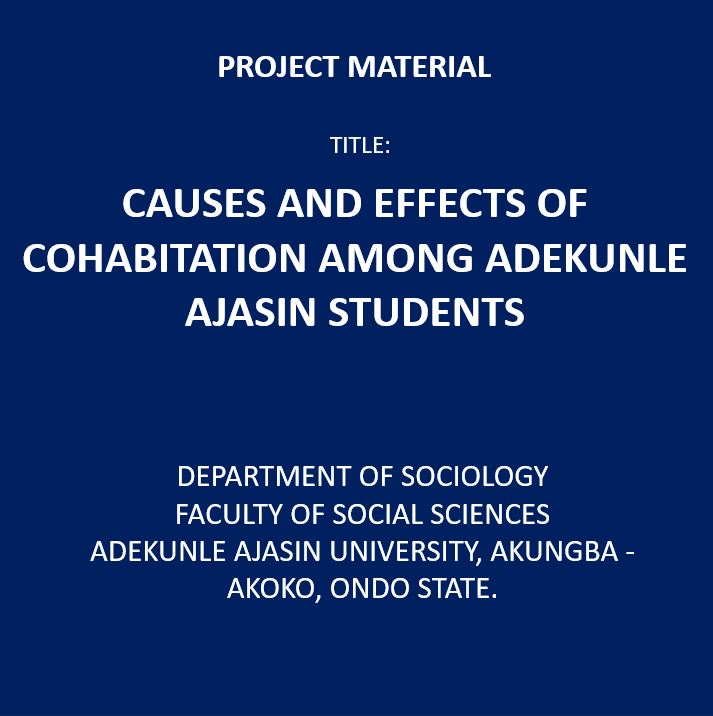No products in the cart.
The Causes and Effects of Cohabitation Among Adekunle Ajasin Students
₦3,500.00
THE CAUSES AND EFFECTS OF COHABITATION AMONG ADEKUNLE AJASIN STUDENTS
- NUMBER OF PAGES: 47
- FILE TYPE: DOC
- DEGREE: BACHELOR
- INSTITUTE: DEPARTMENT OF SOCIOLOGY, FACULTY OF SOCIAL SCIENCES, ADEKUNLE AJASIN UNIVERSITY, AKUNGBA - AKOKO, ONDO STATE.
BACKGROUND OF STUDY
Cohabitation is when two adults live together in the same apartment for the purpose of an emotional and or physically intimate relationship without making the formal commitment of marriage. According to the West Encyclopedia of American Law defines the term cohabitation as couples who are not legally married while Abubakar et al., (2008) explained cohabitation as the act of a man and woman living together and having a coitus intercourse without being married. Prior to 1970, cohabitation was illegal and even considered as a taboo in most countries (Popenoe et al., 1999). Today, as civilization erupted and immeasurably diffused to all continents the practice has become common worldwide. In the United States, the total proportion of cohabitating couples account for 5.5 million households (A Few Facts on Cohabitation- (2001).
Cohabitation as a form of relationship is highly popular among young adults, particularly tertiary students due to the changing sexual codes that make sex more acceptable, shifting tertiary institutions regulations that have permitted tertiary students to live off campus. The listed are further enhanced by emergence of privately owned and accessible accommodations for tertiary students and increased usage of contraception especially the pill (Peterman et al, 1974). Svodziwa and Kurete (2017) note that cohabitation by students is mostly associated to or caused by inadequate accommodation. However, being a major transition in the lives of many undergraduate students, higher education life gives the students the opportunity to decide what to do without the undue influence of their parents (Ekpenyong and Ekpenyong, 2016). Soboye (2013) further identifies the major reasons for student cohabitation to include test of compatibility before marriage, sexual relationship and reduction of cost of living. Stanley et al, (2004) asserted that over half of today’s young adults will live with someone in a romantic relationship before marriage. Therefore, inability of the tertiary institutions to manage the increasing student population through the provision of adequate hostel accommodation, have led to cohabitation among tertiary students in some public institutions (Joan-Nduta, 2006; Arisukwu, 2013).
As cohabitation is short-lived as compared to legal marriages (Tesfaye & Jibat, 2014), a potential breakup and infidelity frequently lead to psychological distress and, in turn, impacts negatively on the emotional well-being of women students (Kheswa & Hoho, 2017). In previous quantitative studies, which investigated the correlation between emotional abuse and sexual relationships among college students, Vidourek (2017) found that the majority of women students reported low self-esteem. Regarding the causal factors and effects of cohabitation at the universities, Ekpenyong and Ekpenyong (2016) established that women students reported insomnia (i.e. lack of sleep), social withdrawal, anxiety and mood swings. Additionally, due to a lack of dedication to their studies, Tanzanian women students who lived in cohabitation reported poor academic performance (Mligo & Otieno, 2018).
Allen (2017) agrees that due to male dominance in many cultures, women students would be physically beaten, raped and kicked upon touching their partners’ mobile phones. Rather than terminating the relationships or laying charges for IPV and rape, women students would ruminate, apologise, promise not to touch the phones, and perform some domestic chores such as cooking and doing the laundry for their male partners (Coelho, Ribeiro & Valente, 2015). Due to socialised acceptance of the rape myth, an alarming number of victims or survivors of IPV tend not to report it to the authority figures at the universities or to the police (Adams, Mabusela & Dlamini, 2013; Dhlomo et al., 2012). There is a concern amongst feminists and activists that in countries such as Australia, the United States and South Africa, the judicial system is slow in convicting rape perpetrators and recognising the rights of women (Le Roux, 2016; Monchgesang, 2015; Phipps et al., 2018).
No product has been found!
